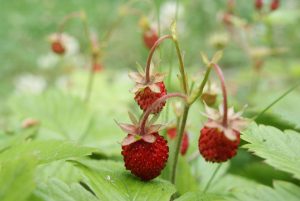 If you make room for one thing in your garden besides vegetables, it should be berry bushes or plants. Whether you choose raspberries, strawberries, blueberries or blackberries is up to you – all are tasty fresh off the plant, in desserts and salads, and can be turned into jellies and jams. If you plant more than variety, you’ll have fresh fruit in spurts all summer long, giving you plenty of fresh fruit right when you need it.
If you make room for one thing in your garden besides vegetables, it should be berry bushes or plants. Whether you choose raspberries, strawberries, blueberries or blackberries is up to you – all are tasty fresh off the plant, in desserts and salads, and can be turned into jellies and jams. If you plant more than variety, you’ll have fresh fruit in spurts all summer long, giving you plenty of fresh fruit right when you need it.
Strawberries
Rather than choose a type of ever-bearing strawberry plant, which will supposedly produce fruit for a long period of time, go for two or more types that ripen at different times. You’ll get more – and better – fruit from them at harvesting time this way. For example, Fairfax strawberries ripen early in the summer, while the Sparkle varietal ripen later. If you plant some of each, you’ll be rewarded with tasty strawberries more than once a growing season. No matter the type, strawberry plants are easy to grow from seed, require a decent amount of light, and prefer soil that’s filled with organic matter. You do have to keep your strawberry patch well-weeded, and keep an eye out for birds, as they love the fruit just as much as humans do.
Blueberries
Like strawberry plants, there are different types of blueberry bushes that ripen at different times of the year. In general, blueberry bushes like acidic soil that drains well, as well as plenty of sunlight. They can be planted in the ground (preferably in a raised bed) or in a container. These plants come back every year, so you’ll have to transfer them to larger containers, or eventually, the ground. Keep in mind that blueberry bushes need to be pruned every year, and you’ll have to remove some of the flower buds on new plants before the fruit will appear. As time goes by, they will bear more and more fruit, so don’t be discouraged if you don’t have a large crop the first year.
Blackberries
Blackberries also grow in bushes, much like blueberries do. However, some types of wild blackberries (and even nursery-purchased ones) are prone to viruses, such as the Raspberry Bushy Dwarf Virus and Blackberry Calico, both of which will turn the leaves yellow. Because of this, you’ll have to look for a very reputable nursery or other source for your blackberry bushes. Once you’ve found the right plants, find a sunny spot in your yard with soil that drains well, and get ready to harvest plenty of blackberries in the fall!
Raspberries
Depending on where you’re located, you’ll need to plant raspberry bushes either in early spring or late fall. These bushes like a lot of moisture, so soak the root before placing them in the ground – and they will need a roomy space so that their roots can spread out. Raspberries also like plenty of water, as well as a lot of sunlight. There are different types of raspberry bushes to choose from, depending on when you want them to produce fruit. You’ll have to decide whether you want an early crop, a late crop, or an everbearer, like Heritage raspberries, that, despite its variety, will grow fruit twice a year, in the spring and fall. Plus, even though the traditional raspberry is a dark red, there are also black, purple, and yellow raspberry varieties, which means that you’ll have yet another decision to make.
Pic by TT Arvind.




No comments yet.